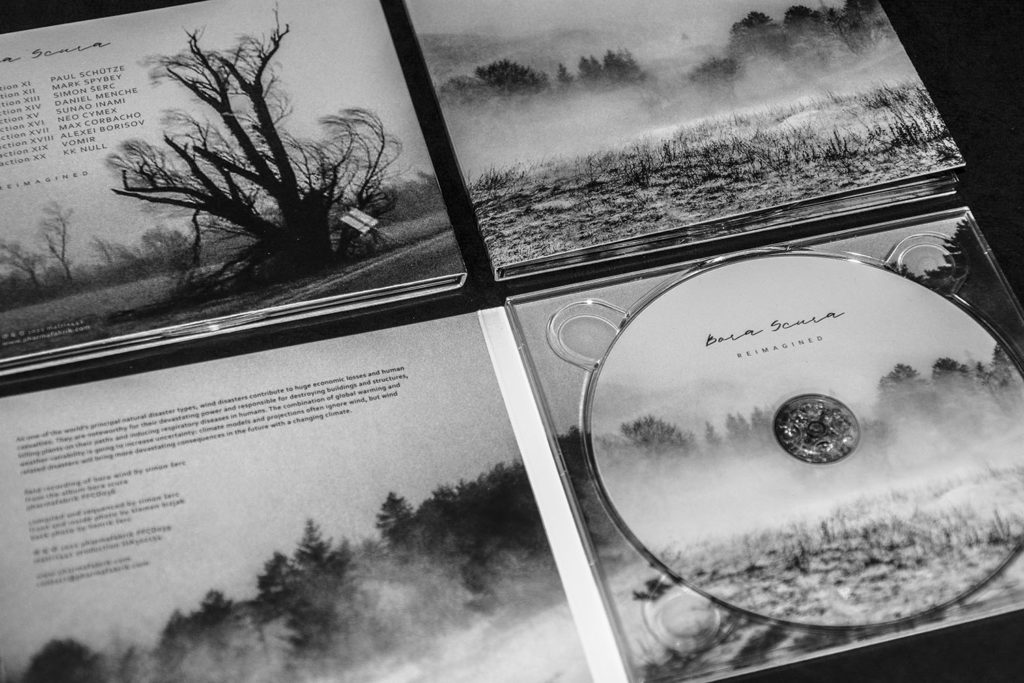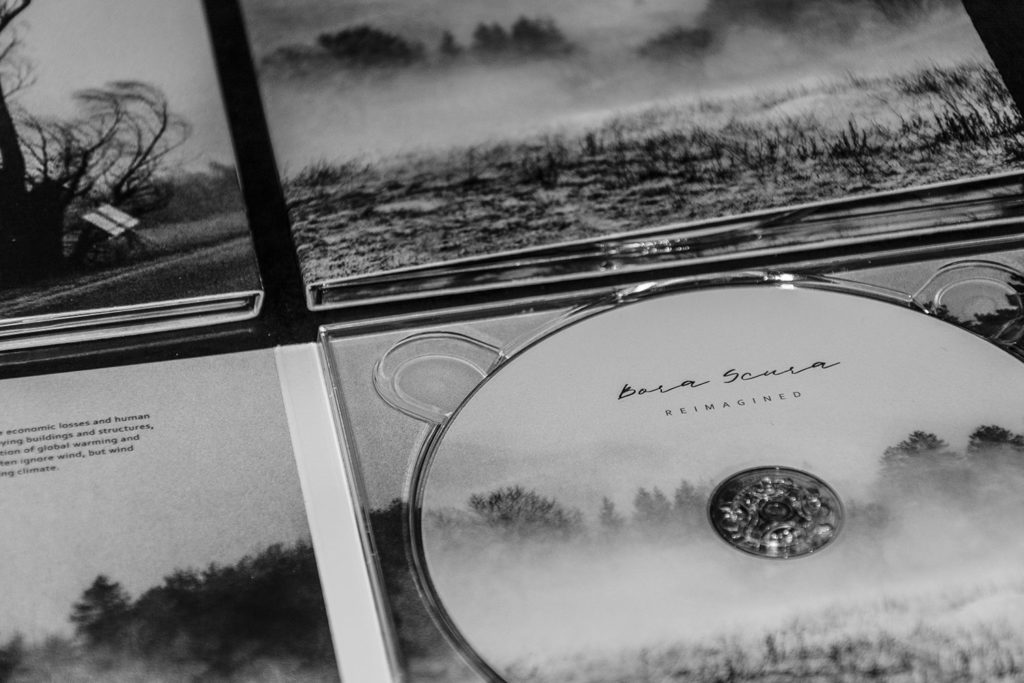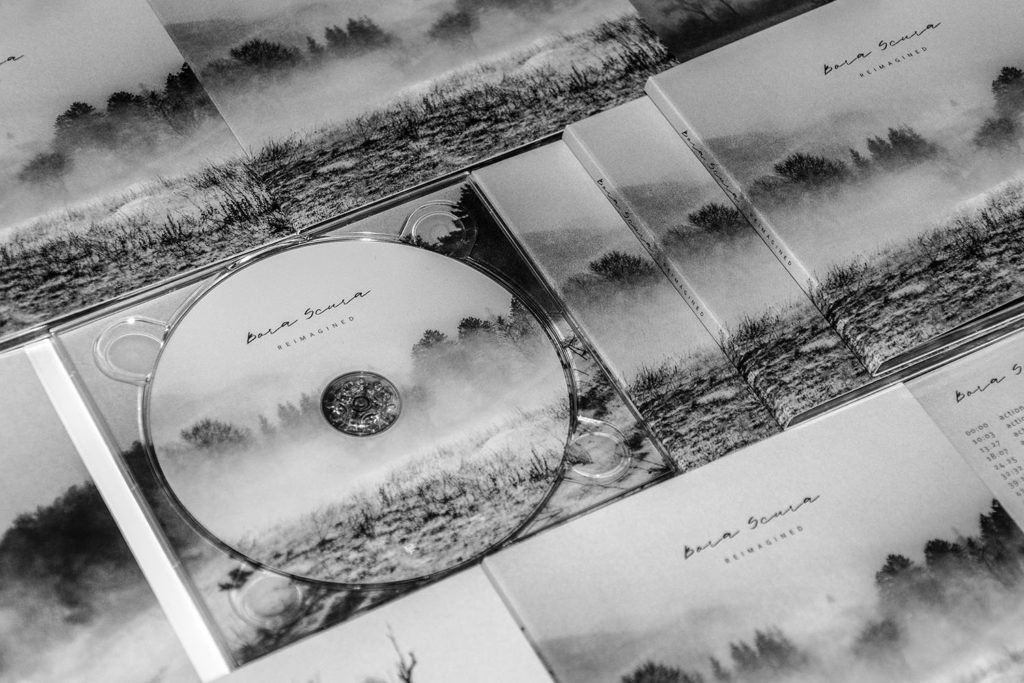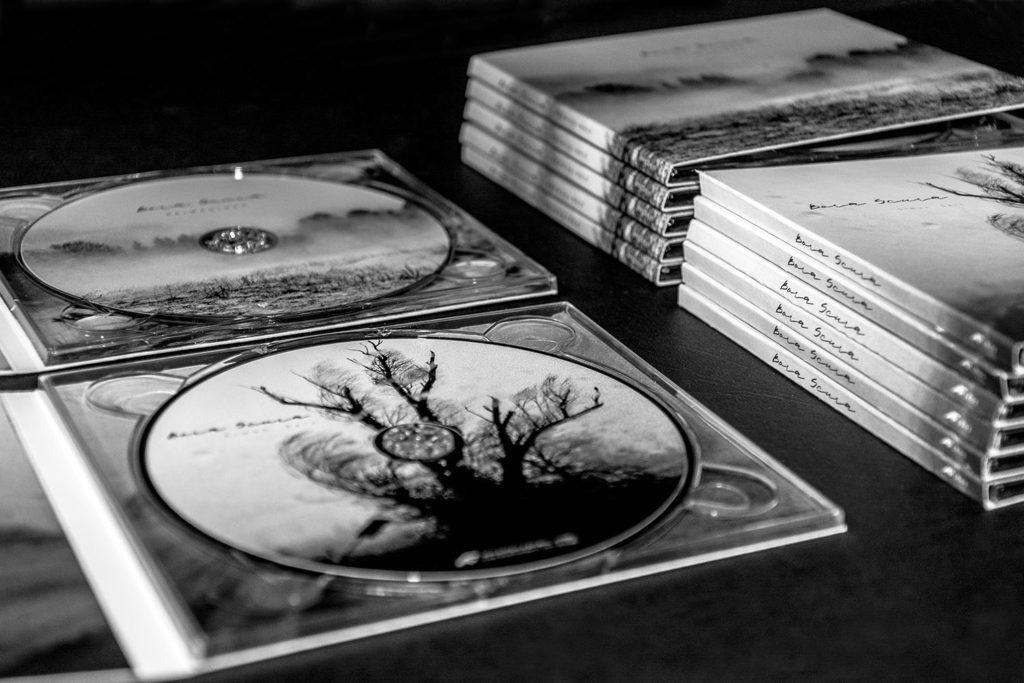Bora Scura Reimagined (interprété par Paul Schütze, Mark Spybey, Daniel Menche, Simon Šerc, Neo Cymex, Max Corbacho, Sunao Inami, Alexei Borisov, Vomir, KK Null.)
Il y a plus de dix ans, j’avais consacré un numéro de Fear Drop à l’esthétique musicale du vent. J’y examinais quelques disques significatifs, dont le monumental Wind Patagonia de Francisco López. Celui-ci avait capté des vents, parmi les plus sauvages de l’hémisphère austral – « les vents les plus rapides du globe » selon Roger Caillois. À l’opposé, ou presque, de la planète, le Slovène Simon Šerc a enregistré quelques années plus tard le terrible vent du nord, Borée, qui souffle plus de quarante jours durant la saison froide dans son pays, puis a publié un album, Bora Scura.
Connaître les aspects les plus dramatiques de l’impact des vents froids et rapides sur l’activité humaine, que Simon Šerc rappelle et place à la même échelle que la pandémie, n’interdit pas de considérer une nouvelle fois le vent et ses rafales pour leur potentiel esthétique.
Souhaitant accorder à la musicalité plus de place, Simon Šerc a décidé d’opérer et de faire opérer une réinterprétation de ses captations de vent. On pense immédiatement à une démarche identique, celle que le label australien Dorobo avait lancée à partir des enregistrements de vent excitant des câbles abandonnés dans le désert, réalisés par Alan Lamb et retraduits par R. Ikeda, Th. Köner, B. Günter et Lustmord.
Mais alors que les quatre musiciens invités par Dorobo devaient travailler une matière déjà vibrante (les câbles se comportant comme des harpes éoliennes), les artistes conviés par Simon Šerc pour Bora Scura Reimagined façonnent la matière du vent sauvage, recueilli soufflant, maltraitant arbres et clôtures, hurlant à la façon de folles divinités antiques.
Le jeu musical se joue alors plus ou moins loin de la texture, chacun laissant souffler plus ou moins librement le courant d’air et agglomérant les grains qu’il charrie pour leur donner forme.
Paul Schütze par exemple, reconstruit en une formule compliquée un jeu percussif de fragments de métal heurtés, tandis qu’il fait naître en fantôme erratique une réverbération de cymbale éclairant un dialogue de vrombissements lointains. Simon Šerc lui-même a pris de la distance et mené une évocation mélancolique par vagues, un fredon crépusculaire et vibrant qui mène au-dessus du ressac, alors que Neo Cymex a poussé le vent jusqu’à la nappe cosmique et Max Cornacho jusqu’au drone.
Un tel travail sur le surplomb de la matière n’est pas dans le propos de Mark Spybey, ou d’Alexei Borisov, qui chacun pénètre au cœur du vent pour le transformer en vibration cyclique synthétique, charriant à la manière d’un flux radiophonique égaré des embryons de ce qui pourrait bien ressembler à des voix. Avec la capacité de puissance et d’abrasion qu’on leur connaît, Daniel Menche (qui avait déjà publié un CD intitulé… Vent) et, plus loin, Vomir, sont encore au plus près de la texture, et font vibrer avec éclat une grenaille pétillante et bientôt respirante.
On peut encore citer, à mi-chemin des nombreuses démarches, celle de Sunao Inami, dont les traitements conservent la dynamique soufflante, mais la compriment en un filin presque lumineux d’où s’élance un nouveau flot granuleux, presque tonal, percutant d’infimes échos qui donnent une nouvelle largeur au paysage ; ou encore K.K. Null qui magnifie la puissance terrifiante du vent de Borée, maltraitant les huisseries et fuyant vers la plaine.
Ici et là le vent a été compris, capturé et ensilé parfois, comprimé puis relancé, traité comme un enfant dont les balbutiements méritent traduction ; c’est semble-t-il ce que souvent les musiciens ont fait : donner voix simplement, ou bien surplomber ou pénétrer de vagues pré-mélodiques. Parfois encore, ils ont soufflé sur les braises, pris la fureur à son jeu pour esthétiser sa violence.
Ces différentes postures s’offrent comme un catalogue des approches du vent – et chacun y préférera son article –, depuis la reprise la plus brute jusqu’à la transformation harmonieuse. On y joue à la fois sur la tension que souligne Simon Šerc (les risques du bouleversement climatique, la fréquence des tempêtes), et sur le geste du paysagiste tragique, celui des peintres qui esthétisèrent le Naufrage en mer ou Les Désastres de la guerre.
LINK: http://www.feardrop.net/?p=3120
Vent extrêmement froid sévissant dans des zones proches de la mer Adriatique, et tout particulièrement dans la région d’Ajdovščina (Slovénie), le Bora dévaste tout sur son passage, détruisant les récoltes et les batiments, semant le chaos là où il passe.
A partir d’enregistrements de terrain de cette force éolienne hors-norme, dix artistes aux origines géographiques diverses, ont sculpté des ambiances sonores aux allures de narration continue, voyage à l’intérieur de paysages désolés, desquels émane une beauté austère et envoûtante.
De Mark Spybey en passant par Daniel Menche, Paul Schütze, Simon Šerc, Sunao Inami, Max Corbacho, Neo Cymex, Alexei Borisov, Vomir ou KK Null, les artistes sélectionnés livrent une oeuvre compacte, reflétant les changements climatiques frappant de plein fouet notre monde actuel, prémices en cours de climats dérangés et imprévisibles, laissant des séquelles chaque jour plus profondes dans certaines régions de notre planète. Un album de field recordings engagé, au goût d’Apocalypse. Très fortement recommandé.
LINK: https://silenceandsound.me/2022/02/14/bora-scura-reimagined/
Let’s kick off this collection of compilations with a collection of unexpected sounds that can hardly be categorized as ‘music’. ‘Noise’ would be a more proper description. To appreciate it, it is good to know something about the Bora Scura:
“The bora is a cold, typically very dry and often gusty katabatic wind from the north-east in areas near the Adriatic Sea. The area of Ajdovščina (Slovenia), is highly exposed to strong and cold bora – its strongest gusts exceed the speed of 200 km/h. The peak frequency occurs in the cold season (November – March). Bora affects people’s everyday lives, causes damage in agriculture, traffic and destroys buildings. In the periods of extremely strong wind people are advised not to leave the buildings due to safety reasons.”
Field recordings of this extreme cold wind were recorded by Simon Šerc and previously released on his Bora Scura album in 2018. But here (as the word ‘reimagined’ already indicates) these recordings are taken to another level by different artists. They use the field recordings as their basic material to create electroacoustic soundscapes that only remotely resemble the original sound of the storm, but retain its violent nature.
Contributing artists are Paul Schütze, Mark Spibey, Daniel Menche, Sunao Inami, Neo Cymex, Max Corbacho, Alexei Borisov, Vomir, KK Null, and the original recording artist Simon Šerc.
With their collection of “violent, intense and almost otherworldly experience of pure sound and pure nature”, they demand attention to the global catastrophe of increasingly extreme weather events. The listening experience is almost as intense as the Bora Scura itself must be.
LINK: https://www.ambientblog.net/blog/2022-01/various-various-6/
In 2018 realiseerde de eveneens met elektronica werkende Simon Šerc het album ‘Bora Skura’, eveneens voor zijn eigen Pharmafabrik. Vorig jaar verzocht hij Paul Schütze, Mark Spybey, Daniel Menche, Neo-Cymex (het alias van Dejan Požegar), Max Corbacho, Sunao Inami, Vomir (het alias van Romain Perrot), KK Null (het alias van Kazuyuki Kishino) en Borisov om met de veldopnames van dit album aan de slag te gaan. ‘Bora Skura Reimagined’ bevat de negen bijdrages, samen met die van Šerc zelf, naadloos in elkaar overlopend, van dit project. De eerste bijdrage, die van Schhütze, is met tien minuten tevens de langste. Hij gebruikt de veldopnames van de wind, aangevuld met donkere klankkleuren, om een sterke spanning te creëren. Een spanning die zich doorzet in het slepende ritme dat Spybey creëert en de bijna symfonische bijdrage van Šerc zelf. Menche kiest er aansluitend voor om de spanning nog verder op te voeren, middels scherpe klanken en tegen chaos aankruipende vervormingen. Met Inami keert de rust terug, de storm wordt een stevige bries. Neo-Cymex kiest er aansluitend voor om de spanning weer op te laten lopen, middels industrieel aandoende klanken, waarna Carbacho weer terugkeert naar een relatieve rust. Dan volgt de bijdrage van Borisov. Ook hij kiest voor een vrij industrieel aandoende aanpak, maar minder extreem dan die van Neo-Cymex. Bijzonder is het vrij subtiele geluidsspectrum dat dient als aanvulling. En dan is er de bijdrage van Vomir. Het is nu definitief gedaan met de rust, dit is pure noise, van het vervaarlijke soort. Tot slot volgt K.K. Null, alsof de machine, nee het volledige fabriekscomplex in elkaar stort, alleen de wind blijft over.
LINK: https://www.nieuwenoten.nl/?p=14766
A Mighty Wind
From the Slovenian label Pharmafabrik Recordings we have the Bora Scura Reimagined (PFCD039) record…it’s a whole album based on field recordings of the bora, a deadly wind that devastates life, limb and architecture in areas around the Adriatic sea, with Slovenia itself being particularly vulnerable to it.
The bora is a so-called “katabatic” wind, which means it carries high-density air from a higher elevation, usually by travelling down a slope and assisted by the force of gravity. It’s not only cold, it’s also extremely forceful and speedy, and during the bora season (November to March) you can expect severe weather warnings in this part of the world, and often Slovenians have to stay indoors due to the perils of these life-threatening, building-flattening blasts. Electric pylons collapse, public buildings close, trees are uprooted, heavy objects hurtle through the air, and traffic is thrown into chaos when these bastards of the air get up to their preferred speed of 100 km per hour. Other areas around the Mediterranean and Black Sea may get their share of this windy horror, but with the hapless Slovenians the whole thing is clearly embedded in their culture, and they dread it with the certainty of a regularly visiting monster from the mountains.
Today’s record may feature a number of contributors, but one starting point was the record Bora Scura made by Simon Serc for this label in 2018, where his field recordings of this demonic puff from Hell were structured into ten named sections (alluding to pressure, stress, flux and similar forces) to bring home the full hideous truth of this icy fiend. Now, ten international sound artists (drawn from the fields of ambient, noise, drone, electronica and such) present their “reimagined” versions of these field recordings, creating this non-stop flurry of textured noise (each track segueing into the next) to present the full appalling majesty of nature’s harsh cruelty. Some of personal faves of Sound Projector, such as Vomir, Alexei Borisov, KK Null and Daniel Menche, plus there’s also the Australian ambient maestro Paul Schutze, Mark Spybey from Zoviet France, Sunao Inami from Japan, Max Corbacho from Spain, and more. Serc, who compiled the record and also contributes one track, doesn’t miss a trick when he points to climate change as a major “global catastrophe”, and reminds us that extreme weather conditions are now more common than ever, and getting worse, because of all the damage we’re continuing to wreak on the environment.
When you hear the utterly terrifying sounds on this record, so vivid and clear you can actually feel the lacerating cold like a steely blade of ice against your flesh, you’d have to be a very hard-hearted climate-change denier to disagree with this proposition. Atmospheric photographs on the digipak are by Klemen Bizjak and Henrik Serc. Wrap up warm and purchase immediately…from 6th April 2022.
LINK: https://www.thesoundprojector.com/2023/05/25/a-mighty-wind/




